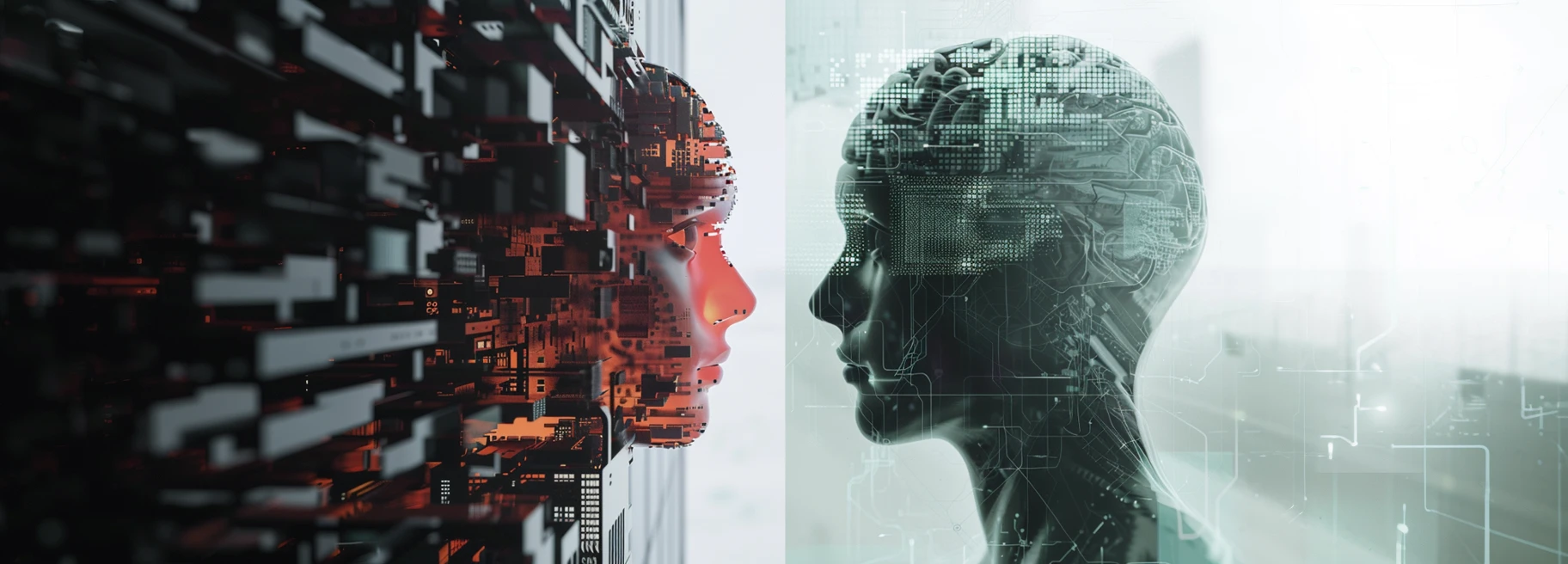
Artificial Intelligence: Abilities and Limitations Explained
READING TIME : 9 MINS

Artificial Intelligence (AI) has quickly become one of the most exciting technological developments of our time. Whether it’s enhancing the capabilities of your smartphone, driving a car, or assisting doctors in diagnosing complex diseases, AI seems to be everywhere. Yet, there’s still a lot of confusion surrounding what AI can and can’t do.
In this post, we’ll demystify AI by diving into its abilities and limitations, exploring how AI systems work, what they’re best suited for, and where their weaknesses lie. So, if you’ve ever wondered whether AI can truly “think” like humans or if we’re on the brink of creating fully autonomous robots, keep reading!
What Exactly is Artificial Intelligence?
Before we dive into AI’s abilities and limitations, let’s clarify what AI actually is. At its core, AI refers to the development of machines or software that can perform tasks typically requiring human intelligence. These tasks might include recognizing speech, playing chess, or even more complex activities like driving a car or making recommendations based on patterns in data.
There are various types of AI, but they broadly fall into two categories:
- Narrow AI: This type of AI is designed to perform a specific task. Think of voice assistants like Siri or Alexa, which are excellent at recognizing speech and providing answers to simple questions but not much else. Almost all the AI we interact with today falls into this category.
- General AI: This is the more advanced concept that refers to machines with the ability to perform any intellectual task that a human can do. General AI remains largely theoretical for now, though it’s the ultimate goal for many researchers.
The Key Abilities of Artificial Intelligence
AI is incredibly powerful, but its abilities are often misunderstood. Let’s look at some areas where AI excels:
1. Data Processing and Pattern Recognition
AI’s ability to process and analyze massive amounts of data is one of its strongest suits. Traditional software can only work with structured data—think of rows and columns in a database. AI, on the other hand, can handle unstructured data such as images, video, and natural language.
AI systems, especially those based on machine learning, are great at detecting patterns that may not be obvious to the human eye. This ability allows AI to perform tasks like:
- Identifying fraudulent transactions in banking
- Diagnosing diseases from medical scans
- Recommending movies or products based on your past behavior
Machine learning models, particularly deep learning networks, are exceptionally skilled at recognizing patterns in large datasets. For instance, facial recognition systems use deep learning to analyze the unique features of a person’s face, enabling technologies like facial ID on smartphones.
2. Automation and Efficiency
AI is a natural fit for automating repetitive and time-consuming tasks. In industries like manufacturing, AI-driven robots handle tasks that would be dangerous, monotonous, or inefficient for humans.
In customer service, chatbots equipped with natural language processing (NLP) can handle common queries and solve simple problems 24/7, freeing up human workers for more complex interactions.
Automation driven by AI is also being widely adopted in fields like transportation (e.g., self-driving cars) and supply chain management, increasing efficiency and reducing operational costs.
3. Decision-Making and Prediction
AI’s ability to analyze historical data makes it a powerful tool for forecasting and decision-making. For example:
- Financial Services: AI can predict stock market trends or assess the risk of lending money to a particular client.
- Healthcare: AI can predict the likelihood of a patient developing a certain condition based on their medical history and lifestyle factors.
- Retail: Retailers use AI to predict demand, adjust prices dynamically, and optimize inventory levels.
Predictive analytics, one of AI’s most practical applications, is helping businesses make smarter decisions and prepare for future events with more confidence.
4. Natural Language Understanding and Generation
AI has made huge strides in understanding and generating human language. You probably interact with this kind of AI every day, whether it’s asking Alexa to play a song or using auto-correct and predictive text while typing.
Thanks to NLP models like GPT (the technology behind this blog!), AI can generate coherent, well-structured sentences and even hold conversations. AI-powered language models are increasingly being used for tasks such as:
- Language translation: Google Translate, for instance, uses AI to translate text between languages with decent accuracy.
- Content generation: AI can help write articles, blog posts, and product descriptions—though, of course, it needs some human oversight to ensure quality.
- Sentiment analysis: Businesses use AI to analyze social media posts and reviews to gauge customer sentiment and respond accordingly.
While these systems can produce impressive results, their ability to understand the meaning behind words is still limited. They excel at identifying patterns in language but lack true comprehension.
More about the latest OpenAI Updates in my next BlogPost!
The Limitations of AI
For all its capabilities, AI is far from perfect. There are several key limitations that remind us that AI, while powerful, is not a magic bullet. Let’s take a closer look at where AI struggles:
1. Lack of General Intelligence
As we mentioned earlier, today’s AI is narrow. This means that while AI can be very good at performing specific tasks, it cannot transfer that knowledge to other tasks. An AI that excels at playing chess, for example, cannot suddenly start driving a car or diagnosing diseases.
In contrast, humans have the ability to generalize across different domains. If you learn how to drive a car, you can probably figure out how to drive a truck or a scooter with minimal extra training. AI lacks this kind of flexibility.
2. Dependence on Data
AI models require vast amounts of data to learn. Without large, well-structured datasets, AI systems are limited in their ability to function properly. If the data is incomplete, biased, or poorly labeled, the AI’s performance will be suboptimal—or even outright wrong.
For example, facial recognition systems have been criticized for poor accuracy when identifying individuals from certain ethnic groups, largely due to biased training data. This is a major issue in fields like healthcare, where biased data could lead to incorrect diagnoses or treatment recommendations.
Moreover, in dynamic environments where real-time learning is required, AI may struggle if it hasn’t been exposed to similar data in the past.
3. Limited Understanding and Context
Although AI can process and generate language, it doesn’t truly understand it. AI language models, for example, don’t have common sense or a deeper understanding of context. This limitation is evident when AI chatbots struggle with conversations that involve nuance, ambiguity, or humor.
AI systems operate based on probabilities and patterns. While they can mimic human conversation convincingly in many cases, they don’t actually grasp the meaning of what they’re saying.
4. Ethical and Legal Concerns
AI can be as dangerous as it is useful if not applied thoughtfully. One of the biggest challenges is ensuring AI operates in a way that is ethical and fair. Some common concerns include:
- Bias: AI models can unintentionally perpetuate biases present in the training data, leading to unfair treatment of individuals based on gender, race, or other factors.
- Privacy: AI systems often rely on vast amounts of personal data, raising concerns about how this data is used and who has access to it.
- Job Displacement: While AI can boost productivity, it can also automate jobs, potentially leading to job losses in certain sectors.
There are ongoing debates about how to regulate AI to minimize these risks. Governments, tech companies, and civil rights groups are all trying to navigate this complex landscape, but solutions are far from clear-cut.
5. Creativity and Originality
While AI can assist in creative processes, it struggles to generate genuinely original ideas. AI works by analyzing and combining existing patterns, but it doesn’t have the ability to think outside the box or come up with groundbreaking innovations.
For instance, an AI model trained to generate art can create new paintings based on styles it has learned from its training data. However, it won’t produce an entirely new artistic movement. Similarly, AI writing tools can assist with content generation, but they still rely on human creativity to craft truly unique narratives.
The Future of AI: Where Do We Go From Here?
AI is advancing at a rapid pace, but what does the future hold? There are a few key areas where we can expect significant progress:
1. Improved Generalization
One of the major research goals in AI is developing models that can generalize better across tasks. While we’re still a long way from achieving general AI, researchers are working on improving transfer learning, a technique that allows AI models to apply knowledge from one domain to another.
In the coming years, we might see more AI systems that can handle multiple tasks without needing to be retrained from scratch each time.
2. More Ethical AI
As AI becomes more integrated into society, there will be increasing pressure to ensure that it is used ethically. Companies are already working on ways to reduce bias in AI models, and governments are starting to create frameworks to regulate AI.
The hope is that with more oversight and transparency, AI systems will become safer and fairer for everyone.
3. Human-AI Collaboration
Rather than replacing humans, AI is more likely to serve as a tool to augment human capabilities. In industries like healthcare, AI can help doctors diagnose diseases more accurately, but it won’t replace their expertise. Similarly, in creative fields, AI tools can assist writers, artists, and musicians without eliminating the need for human input.
The future of AI is likely to be one of collaboration, where humans and machines work together to achieve things that neither could accomplish alone.
Conclusion: AI’s Abilities and Limitations in Perspective
Artificial Intelligence is undoubtedly a powerful tool that is transforming industries and our daily lives. Its ability to process data, recognize patterns, and automate tasks makes it an invaluable asset in today’s digital age. However, it’s important to understand that AI is not without its limitations. It lacks the general intelligence, creativity, and contextual understanding that humans possess, and it still struggles with ethical challenges.
If you’re interested in learning more about how AI can be applied to your business or personal projects, check out our AI Workshops and Courses. And don’t forget to subscribe to our newsletter to stay updated on the latest in AI trends and innovations!
Feel free to drop your thoughts in the comments below—what excites or worries you most about AI’s future? Let’s get the conversation started!
Share this post
Written by: Sophie Pochtler
Sophie is a Product Designer with over 10 years of experience in Product Development at a technology firm in the food industry. Her passion for innovation and the daily use of AI over the past 3 years have shaped her into a solution-oriented innovator. Embracing the principles of human-centered design, she collaborates closely with businesses to comprehend their unique goals and challenges and develops tailored solutions to perfectly match her clients need.
Follow Us
What is this article about?
- What Exactly is Artificial Intelligence?
- The Key Abilities of Artificial Intelligence
- The Limitations of AI
- The Future of AI: Where Do We Go From Here?
- Conclusion: AI’s Abilities and Limitations in Perspective
- Share this post
- Subscribe to our AI Newsletter
- WEEK 40: Nazca Lines & AI
- WEEK 40: AI Safety Bill
- WEEK 40: Microsoft CoPilot



